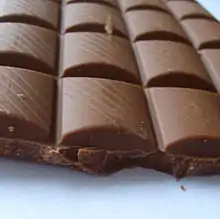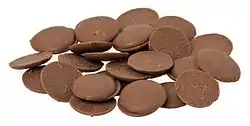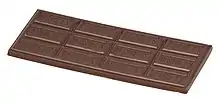Milk chocolate
Milk chocolate is a solid chocolate confectionery containing cocoa, sugar and milk. The most popular form of chocolate in many countries, milk chocolate was originally sold solely as a chocolate bar but is now available in a variety of forms. Major milk chocolate producers include Ferrero, Hershey, Mondelez, Mars and Nestlé. Between them, they are responsible for over half of the chocolate sold worldwide. Although four-fifths of all milk chocolate is sold in the United States and Europe, increasingly large amounts are consumed in China and Latin America. While taste and texture have been key to its success, milk chocolate has also historically been promoted as a healthy food, particularly for children. Recent evidence has shown that it may provide antioxidant health benefits.
 Milk chocolate bar | |
| Type | Confectionery |
|---|---|
| Place of origin | Switzerland |
| Created by | Daniel Peter |
| Invented | 1875 |
| Main ingredients | |
The word chocolate arrived in the English language about 1600, but initially described dark chocolate. The first use of the term "milk chocolate" was for a beverage brought to London from Jamaica in 1687, but it was not until the Swiss inventor Daniel Peter successfully combined cocoa and condensed milk in 1875 that the milk chocolate bar was invented. Switzerland quickly developed as the centre of milk chocolate production, particularly after the development of the conche by Rodolphe Lindt, and was increasingly exporting to an international market. Milk chocolate became mainstream at the beginning of the twentieth century following the launch of Cadbury Dairy Milk and the Hershey bar, while Belgium saw a blossoming of chocolatiers with ninety manufacturers in Brussels alone by the 1920s. At the same time, milk chocolate was combined with other ingredients, like nougat, to form a wide variety of bars, including Toblerone in 1908, Goo Goo Cluster in 1912 and Kit Kat in 1935. The global spread of milk chocolate continued into the next century, along with increasing consolidation in the market. A more recent development has been the rise of Fair Trade and UTZ Certified chocolate aiming to provide ethical assurances for customers. In 2018, the market for milk chocolate was worth $63.2 billion.
History
The word "chocolate" was first used in English about 1600.[1] The word derives from xocolātl, from Nahuatl, the language of the Aztecs, influenced by the Yucatec Mayan word chocol, "hot", with the Nahuatl word atl, "water".[2] The first instance of "milk chocolate" appeared soon after, referring to a drink of chocolate combined with milk. In 1687, Hans Sloane, an Irish physician and collector, introduced the beverage to London after seeing the people of Jamaica enjoying the drink.[3] The preparation was known for its medicinal properties, and was manufactured by Nicholas Sanders and William White, and was soon joined by other milk chocolates around the city.[4] From there, milk chocolate spread, first to France, where the pharmacist to Louis XVI, Sulpice Debauve, introduced the drink to the Court, and then further afield, reaching as far as the United States by 1834.[5] Meanwhile, in Dresden in the German Confederation, Jordan & Timaeus were developing a mechanism to produce hard chocolate using steam power. On 23 May 1839, they advertised a solid chocolate containing milk, calling it "steam chocolate" (dampfchocolade).[6] However, when Fry's of Bristol in the UK created the first chocolate bar in 1847, they used dark chocolate.[7]

In 1875, the Swiss inventor Daniel Peter first successfully combined cocoa mass, cocoa butter, and sugar with condensed milk, recently created by Henri Nestlé, to produce milk chocolate.[8] The process was further refined by another Swiss chocolatier, Rodolphe Lindt, who developed the conche, which created a smoother product.[9] From these developments, Switzerland soon dominated the chocolate market. Production increased dramatically, and by 1905, the country was producing 15,000 tonnes (15,000 long tons; 17,000 short tons) of chocolate, a vast proportion of it exported.[10]
Meanwhile, there were other developments outside Switzerland. Swiss dominance was challenged in 1905 by a product from England, Cadbury Dairy Milk. Although there had been other milk chocolates produced outside Switzerland before – Cadbury themselves had produced one in 1897 – they were coarse and generally inferior to the Swiss varieties, and consequently suffered from low sales. In contrast, Dairy Milk quickly rose in prominence and, by the 1920s, was the bestselling chocolate in the UK.[11] Simultaneously, in 1900, Milton Hershey had introduced the first Hershey bar, which revolutionised the popularity of milk chocolate in the United States. Although initially only available in Pennsylvania, by 1906 it was sold across the country.[12] Popularity blossomed, particularly following World War I, when the United States Army issued chocolate bars to troops, for many their first taste of milk chocolate.[13]

Over the decades, milk chocolate manufacture spread worldwide and new brands appeared. In 1910, Arthur and George Ensor created the first milk chocolate in Canada, using milk from Jersey cows.[14] At the same time, Belgian chocolate production also expanded rapidly. From small beginnings in the 1870s, by the 1920s, there were ninety chocolate manufacturers around Brussels alone.[15] In 1926, Meiji brought out their bar, the first example to be made in Japan.[16] Milk chocolate swiftly dominated chocolate sales in most markets.[17] It even found a place during World War II, when US troops carried D Ration chocolate, nicknamed Logan Bars after Quartermaster Paul Logan, as an emergency supply.[18] At the same time, new ways of presenting chocolate appeared, from different shapes, like Cadbury Buttons, to the profusion of boxed varieties that became a feature of Belgian chocolate.[19]

At the same time, the number of independent manufacturers declined sharply. The first consolidations in the industry were in Switzerland, where the takeover of Lindt by Sprüngli took place in 1899, and Nestlé had already emerged as the largest manufacture in the country by 1929.[20] However, pace quickened in the latter half of the century. During the last three decades of the twentieth century, there were over 200 takeovers in the industry. By 2001, over half the global chocolate market was held by 17 companies. By 2013, the top four manufacturers, Mondelez, Mars, Nestlé and Ferrero, comprised 49 percent of the sales.[21] This has continued; for example, in 2015, Thorntons, the British chocolatier that in four years before had produced the largest chocolate bar in the world weighing 5,792.50 kilograms (12,770.3 lb), was taken over by Ferrero.[22][23]
In 2018, the global market for milk chocolate was worth $63.2 billion, and is expected to approach $73 billion by 2024.[24] Consumption is dominated by the United States and Europe, which between them consumed over 80 percent of global production. However, the new century saw expansion in different markets. For example, between 2000 and 2013, the areas that saw the highest growth included the Middle East and Africa (where retail value rose 239 percent), Latin America (up 228 percent).[25] Even in China and Japan, which traditionally are places of very low milk consumption, milk chocolate sales increased at the start of the 21st Century. Between 1999 and 2003, Chinese chocolate imports rose from $17.7 million to $50 million.[26] By 2007, over 38 percent of chocolate sales in China were milk chocolate.[27] By 2018, the value of sales by Japanese chocolatier Meiji was approaching that of the top producers in Europe, and the total sales by the group had surpassed the total for all confectionary sales by Hershey, putting the American company outside a top five ranking.[28]
Nutrition
| Nutritional value per 100 g | |
|---|---|
| Energy | 2,364 kJ (565 kcal) |
50.8 | |
37.6 | |
| Vitamins | Quantity %DV† |
| Thiamine (B1) | 10% .112 mg |
| Riboflavin (B2) | 25% .298 mg |
| Niacin (B3) | 3% .386 mg |
| Vitamin B12 | 31% .75 μg |
| Vitamin E | 3% .51 mg |
| Minerals | Quantity %DV† |
| Calcium | 19% 189 mg |
| Iron | 18% 2.35 mg |
| Magnesium | 18% 63 mg |
| Manganese | 22% .47 mg |
| Phosphorus | 30% 208 mg |
| Potassium | 8% 372 mg |
| Selenium | 6% 4.5 μg |
| Zinc | 24% 2.3 mg |
| |
| †Percentages are roughly approximated using US recommendations for adults. Source: [29][30] | |
While all milk chocolate contains cocoa, milk and sugar, the proportion of these ingredients varies between countries and brands, which in turn affects its nutritional value. The driving force for these differences is taste. For example, Belgian chocolate is known for its mild milky flavour, while some Russian brands have a strong cocoa taste.[31] The taste drives the ingredients, although these are also affected by other factors, particularly economics. For example, cost is the main reason for the introduction of cocoa butter replacements like coconut and palm oil. However, there are also regulatory reasons. In 1973, for example, the European Union decreed that chocolate must have a minimum of 35 percent dry cocoa solids.[32] More recently, China has also introduced legislation to require locally produced milk chocolate to contain 25 percent cocoa butter.[33]
All these have effects on human health and in the 21st Century, milk chocolate lost market to dark chocolate which is considered more healthy.[34] However, this has not always been the case. Milk chocolate has been presented as a health food since Cadburys first advertised Sloane's Milk Chocolate for its medicinal properties in the 19th Century.[5] The health benefits to children were particularly highlighted. For example, in the 1920s, the Baby Ruth bar was touted as a nutrition food for children with no less authority than Allan Roy Dafoe, who had gained fame for delivering the Dionne quintuplets.[35] At the same time, advertisements pronounced that chocolate bars combined both a source of essential energy and the "perfectly balanced food" of milk.[36]
The benefits claimed were broad. Cocoa butter, for example, as it coated the teeth, was claimed to reduce tooth decay.[37] Chocolate was claimed to produce calming effects, reducing stress, and even producing a similar feeling to falling in love.[38] Scientific evidence increasingly backed up claims for the health benefits of chocolate. For example, magnetic resonance imaging (MRI) scans have demonstrated that chocolate consumption can reduce the risk of heart disease. A typical milk chocolate bar also contains about 20 milligrams (0.31 gr) caffeine per 100 grams (3.5 oz), which can stimulate the nervous system and help the body balance its internal water balance.[39] At the same time, the amount of caffeine is a concern to some healthy living advocates.[40] Chocolate is also a source of polyphenols that have antioxident properties, which may also have health benefits.[29]
Production

Milk chocolate is manufactured from cocoa, milk and sugar. The ingredient which defines the product as chocolate, cocoa bean, is mainly grown in Southeast Asia, South America, and West Africa, particularly the Ivory Coast, which supplies 40 percent of the total global cocoa market.[41] Once the cocoa pods are harvested, the seeds, known as "beans", are removed and fermented, then dried. They are then taken to a processing plant where they are cleaned and roasted.[42] The beans are then ground, usually in a two-stage process, first with an impact mill to liquify the cocoa, and then a ball mill. The liquified cocoa liquor is then separated into cocoa mass and cocoa butter.[43]
At this stage, the two other key ingredients come into the process. Milk is often added in powdered form as excess water would damage the flowing properties of the liquid chocolate.[17] Spray dried full fat milk powder is normally used, but alternatives include anhydrous full fat or skimmed milk powders.[44] Condensed milk is preferred by some manufacturers, particularly where milk production is seasonal.[45] Milk substitutes like rice milk are used to create lactose-free milk chocolate.[46] Sugar, the last major ingredient, is added at the same time as the milk powder, either in a roll refiner or conche. Sugar is an international commodity, with production of sugar cane led by Brazil, India, Thailand, China and Australia.[47] Sugar beet is also used.[44] Sometimes the milk and sugar are mixed separately before being added to the liquid cocoa mass and cocoa butter.[48] The liquid chocolate is then poured into moulds and formed into bars.[49]
Milk chocolate combination bars
At the beginning of the 20th century, bars which combined milk chocolate with other sweet ingredients appeared on both sides of the Atlantic. Theodor Tobler and Emil Baumann invented Toblerone in Switzerland in 1908 which contained almonds, honey and nougat.[50] In the United States, the Goo Goo Cluster was first introduced in 1912 which added caramel, marshmallow and peanuts to the list of ingredients.[51] These were soon followed, in 1914, by Fry's Turkish Delight in the UK.[52] Shortly afterwards, Clark introduced the Clark Bar, which has been called the first combination bar, in 1917.[53] In 1920, Otto Schnering of the Curtiss Candy Company created the Baby Ruth bar. By 1925, it was the most popular bar in the US.[54] Soon afterwards, two other brands that would become global giants followed, the Mars Bar in 1932 and, three years later, Rowntree's introduced the Kit Kat.[55] By 2014, 650 Kit Kat bars were being consumed each second.[56] Combination bars came to dominate the confectionery market with sales surpassing $140 billion in 2018.[57]
Ethical issues
Ethical issues have been intrinsically linked to milk chocolate since the early days. Many of the early chocolatiers, including Cadbury, Fry's, Rowntree's and Terry's, were founded by Quakers who saw the wellbeing of their workers part of their business ethic.[58] The companies were pioneers in social welfare, providing a safe working environment, high quality housing and other benefits to employees that were ahead of many of the industrial norms.[59] Cadbury, for example, provided paid holidays, insurance and night schools for workers, as well as constructing Bournville in Birmingham, UK.[60] However, the working conditions of many in the wider chocolate supply chain remained poor. Slavery, and later bonded labour, was often employed on the plantations that provided the sugar used to make chocolate.[61] Even after the abolition of slavery, the working conditions in many plantations was still poor, with reports of child labour being frequent and unreported.[62] In 1975, the first in a series of International Cocoa Agreements tried to set what were termed "fair labour conditions" and eliminate child labour.[63]
Rising consumer awareness, as well as greater corporate and employee interest, led to increasing voluntary action to address human rights issues.[64] Fundamental to this has been the rise of Fair Trade and UTZ Certified chocolate.[65] Initially launched by Stichting Max Havelaar in the Netherlands in 1988, the Fair Trade movement expanded into the mainstream in the following decades, with cocoa second to coffee in terms of sales and volume by 2011. Much of this is driven by the use of Fair Trade ingredients by major brands.[66] For example, in Germany, major supermarket Lidl commenced promoting their own brand milk chocolate with their own Fair Trade label in 2006.[67] Similarly, in the UK, two of the best selling milk chocolate bars, Cadburys Dairy Milk and Nestlé's Kit Kat were marketed with a Fair Trade label starting in 2009 and 2010 respectively.[66]
References
Citations
- "Chocolate". The American Heritage Dictionary. Archived from the original on 17 May 2008. Retrieved 9 May 2009.
- Coe & Coe 2019, p. 121.
- Wilson & Hurst 2012, p. 84.
- Coe & Coe 2019, p. 136.
- Wilson & Hurst 2012, p. 85.
- Fabian, Möge & Wünsche 2006, p. 199.
- Goldstein 2015, p. 157.
- Wilson & Hurst 2012, p. 97–98.
- Beckett 2015, p. 4.
- Fromm 2019, p. 75.
- Martin 2016, p. 44.
- Goldstein 2015, p. 33.
- Smith 2011, p. 131.
- Carr 2003, p. 24.
- Goldstein 2015, p. 306.
- Kusher 2012, p. 140.
- Beckett 2015, p. 23.
- Wilson & Hurst 2012, p. 119.
- Wohlmuth 2017, p. 498.
- Fromm 2019, p. 74–75.
- Poelmans & Swinnen 2019, p. 32.
- "Largest chocolate bar by weight". Guinness World Records.
- Butler & Farrell 2015.
- IMARC 2018, p. 4.
- Poelmans & Swinnen 2019, p. 34.
- Mo, Rozelle & Zhang 2019, p. 177.
- Li & Mo 2019, p. 393.
- Fromm 2019, p. 76.
- Moramarco & Nemi 2019, p. 137.
- Lambert 2017, p. 523.
- Wohlmuth 2017, p. 493–494.
- Meloni & Swinnen 2019, p. 287.
- Mo, Rozelle & Zhang 2019, p. 174.
- Moramarco & Nemi 2019, p. 139.
- Wilson & Hurst 2012, p. 111.
- Wilson & Hurst 2012, p. 133–134.
- Wilson & Hurst 2012, p. 135.
- Wilson & Hurst 2012, p. 136–138.
- Lambert 2017, p. 524.
- Smith 2011, p. 128.
- Beckett 2015, p. 9.
- Beckett 2017, p. 5.
- Beckett 2015, p. 44.
- Wohlmuth 2017, p. 494.
- Beckett 2015, p. 2.
- Byrne 2010.
- Goldstein 2015, p. 698.
- Beckett 2017, p. 6.
- Beckett 2017, p. 4.
- Morton & Morton 1986, p. 109.
- Smith 2011, p. 86.
- Martin 2016, p. 46.
- Smith 2011, p. 52.
- Smith 2011, p. 211.
- Martin 2016, p. 46–47.
- Wright 2019, p. 159.
- IMARC 2018, p. 5.
- Burns Windsor 1980, p. 141.
- Burns Windsor 1980, p. 89–90.
- Smith 2011, p. 75.
- Poelmans & Swinnen 2019, p. 17–18.
- Fromm 2019, p. 78.
- Meloni & Swinnen 2019, p. 293.
- Meloni & Swinnen 2019, p. 293–294.
- Meloni & Swinnen 2019, p. 292.
- Stenzel 2011, p. 1.
- Langen & Hartmann 2019, p. 260.
Bibliography
- Beckett, Steve T. (2015). The Science of Chocolate. London: Royal Society of Chemistry. ISBN 978-0-85404-970-7.
- Beckett, Steve T. (2017). "Traditional Chocolate Making". In Beckett, Steve T.; Fowler, Mark S.; Ziegler, Gregory R. (eds.). Beckett's Industrial Chocolate Manufacture and Use. Chichester: Wiley. pp. 1–8. ISBN 978-1-11878-014-5.
- Burns Windsor, David (1980). The Quaker Enterprise: Friends in Business. London: Frederick Muller Ltd. ISBN 978-0-58410-257-4.
- Butler, Sarah; Farrell, Sean (22 June 2015). "Thorntons bought by Ferrero for £112m". The Guardian. Archived from the original on 22 June 2015.
- Byrne, Janes (5 September 2010). "Barry Callebaut optimises dairy-free milk chocolate alternative". Confectionery News. Archived from the original on 3 September 2020.
- Carr, David (2003). Candymaking in Canada. Toronto: Dundurn Press. ISBN 978-1-550-02395-4.
- Coe, Sophie D.; Coe, Michael D. (2019). The True History of Chocolate. London: Thames and Hudson. ISBN 978-0-50029-474-1.
- Fabian, Maike; Möge, Sirko; Wünsche, Katja (2006). "Lever mit Schokolade: Wie sich Desdner Geschmacksinn entwickelte" [Leveraging chocolate: How Dresden's sense of taste developed]. Dresden: ethnografische Erkundungen einer Residenzstadt [Dresden: An Ethnographic Exploration of a Royal Seat] (in German). Leipzig: Leipzig University Press. pp. 177–207. ISBN 978-3-86583-118-7.
- Fromm, Ingrid (2019). "From Small Chocolatiers to Sustainable Sourcing: A Historical Review of the Swiss Chocolate Industry". In Squicciarini, Johan F. M.; Swinnen, Mara P. (eds.). The Economics of Chocolate. Oxford: Oxford University Press. pp. 71–87. ISBN 978-0-19883-340-6.
- Goldstein, Darra (2015). The Oxford Companion to Sugar and Sweets. Oxford: Oxford University Press. ISBN 978-0-19931-339-6.
- IMARC (2018). Milk Chocolate Market: Global Industry Trends, Share, Size, Growth, Opportunity and Forecast 2019-2024 (Report). Arlington: IMARC.
- Kusher, Barak (2012). "Sweetness and Empire". In Franks, Penelope; Hunter, Janet (eds.). The Historical Consumer: Consumption and Everyday Life in Japan, 1850–2000. Basingstoke: :Palgrave-Macmillan. pp. 127–150. ISBN 978-0-230-27366-5.
- Lambert, Joshua D. (2017). "Nutritional and Health Aspects of Chocolate". In Beckett, Steve T.; Fowler, Mark S.; Ziegler, Gregory R. (eds.). Beckett's Industrial Chocolate Manufacture and Use. Chichester: Wiley. pp. 521–531. ISBN 978-1-11878-014-5.
- Langen, Nina; Hartmann, Monika (2019). "Chocolate Brands' Communication of CSR in Germany". In Squicciarini, Johan F. M.; Swinnen, Mara P. (eds.). The Economics of Chocolate. Oxford: Oxford University Press. pp. 247–267. ISBN 978-0-19883-340-6.
- Li, Fan; Mo, Di (2019). "The Burgeoning Chocolate Market in China". In Squicciarini, Johan F. M.; Swinnen, Mara P. (eds.). The Economics of Chocolate. Oxford: Oxford University Press. pp. 383–399. ISBN 978-0-19883-340-6.
- Martin, Kathy (2016). Famous Brand Names and Their Origins. Barnsley: Pen & Sword History. ISBN 978-1-78159-015-7.
- Meloni, Giulia; Swinnen, Loreto (2019). "Chocolate Regulations". In Squicciarini, Johan F. M.; Swinnen, Johan (eds.). The Economics of Chocolate. Oxford: Oxford University Press. pp. 268–306. ISBN 978-0-19883-340-6.
- Mo, Di; Rozelle, Scott; Zhang, Linxiu (2019). "Chocolate Brands and Preferences of Chinese Consumers". In Squicciarini, Johan F. M.; Swinnen, Mara P. (eds.). The Economics of Chocolate. Oxford: Oxford University Press. pp. 170–179. ISBN 978-0-19883-340-6.
- Moramarco, Stefania; Nemi, Loreto (2019). "Nutritional and Health Effects of Chocolate". In Squicciarini, Johan F. M.; Swinnen, Mara P. (eds.). The Economics of Chocolate. Oxford: Oxford University Press. pp. 134–156. ISBN 978-0-19883-340-6.
- Morton, Marcia; Morton, Freceric (1986). Chocolate, an Illustrated History. Oxford: Crown. ISBN 978-0-51755-765-5.
- Noble, Mark D. (2017). "Chocolate and the Consumption of Forests: A Cross-National Examination of Ecologically Unequal Exchange in Cocoa Exports". Journal of World-Systems Research. 23 (2): 236–268. doi:10.5195/JWSR.2017.731.
- Poelmans, Eline; Swinnen, Johann (2019). "A Brief Economic History of Chocolate". In Squicciarini, Johan F. M.; Swinnen, Mara P. (eds.). The Economics of Chocolate. Oxford: Oxford University Press. pp. 11–42. ISBN 978-0-19883-340-6.
- Smith, Andrew F. (2011). Fast Food and Junk Food: An Encyclopedia of What We Love to Eat. Santa Barbara: Greenwood. ISBN 978-0-31339-394-5.
- Stenzel, Paulette L. (2011). "Mainstreaming Fair Trade: From Coffee and Chocolate to Clothing and Beyond" (PDF). GlobalEdge Business Review. 5 (5): 1–2.
- Wilson, Philip K.; Hurst, W. Jeffrey (2012). Chocolate as Medicine: A Quest Over the Centuries. London: Royal Society of Chemistry. ISBN 978-1-84973-411-0.
- Wohlmuth, Edward G. (2017). "Recipes". In Beckett, Steve T.; Fowler, Mark S.; Ziegler, Gregory R. (eds.). Beckett's Industrial Chocolate Manufacture and Use. Chichester: Wiley. pp. 492–508. ISBN 978-1-11878-014-5.
- Wright, Kai D. (2019). Follow the Feeling: Brand Building in a Noisy World. Hoboken: Wiley. ISBN 978-1-11960-049-7.
